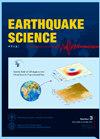3D crustal density modeling of Egypt using GOCE satellite gravity data and seismic integration
IF 1.2
4区 地球科学
Q3 Earth and Planetary Sciences
引用次数: 0
Abstract
A 3D crustal model was constructed using a combination of cutting-edge techniques, which were integrated to provide a density model for Egypt and address the sporadic distribution of seismic data. These techniques include obtaining gravity data from the Gravity Field and Steady-State Ocean Circulation Explorer (GOCE), creating seismic profiles, analyzing the receiver functions of seismic data, obtaining information from boreholes, and providing geological interpretations. GOCE satellite gravity data were processed to construct a preliminary model based on nonlinear inversions of the data. A regional crustal thickness model was developed using receiver functions, seismic refraction profiles, and geological insights. The inverted model was validated using borehole data and compared with seismic estimates. The model exhibited strong consistency and revealed a correlation between crustal thickness, geology, and tectonics of Egypt. It showed that the shallowest depths of the Moho are located in the north along the Mediterranean Sea and in the eastern part along the Red Sea, reflecting an oceanic plate with a thin, high-density crust. The deepest Moho depths are located in the southwestern part of Egypt, Red Sea coastal mountains, and Sinai Peninsula. The obtained 3D model of crustal thickness provided finely detailed Moho depth estimates that aligned closely with geology and tectonic characteristics of Egypt, contributing valuable insights into the subsurface structure and tectonic processes of region.
利用GOCE卫星重力数据和地震积分进行埃及三维地壳密度模拟
结合尖端技术构建了三维地壳模型,为埃及提供了密度模型,并解决了地震数据的零星分布问题。这些技术包括从重力场和稳态海洋环流探测器(GOCE)获取重力数据,创建地震剖面,分析地震数据的接收函数,从钻孔中获取信息,以及提供地质解释。对GOCE卫星重力数据进行处理,建立了基于非线性反演的初步模型。利用接收函数、地震折射剖面和地质资料建立了区域地壳厚度模型。利用井眼数据对反演模型进行了验证,并与地震估计结果进行了比较。该模型具有很强的一致性,并揭示了埃及地壳厚度、地质和构造之间的相关性。结果表明,莫霍构造的最浅深度位于地中海北部和红海东部,反映了一个薄而高密度地壳的海洋板块。最深的莫霍深度位于埃及西南部、红海沿岸山脉和西奈半岛。获得的地壳厚度3D模型提供了非常详细的莫霍深度估计,与埃及的地质和构造特征密切相关,为了解该地区的地下结构和构造过程提供了有价值的见解。
本文章由计算机程序翻译,如有差异,请以英文原文为准。
求助全文
约1分钟内获得全文
求助全文
来源期刊

Earthquake Science
GEOCHEMISTRY & GEOPHYSICS-
CiteScore
1.10
自引率
8.30%
发文量
42
审稿时长
3 months
期刊介绍:
Earthquake Science (EQS) aims to publish high-quality, original, peer-reviewed articles on earthquake-related research subjects. It is an English international journal sponsored by the Seismological Society of China and the Institute of Geophysics, China Earthquake Administration.
The topics include, but not limited to, the following
● Seismic sources of all kinds.
● Earth structure at all scales.
● Seismotectonics.
● New methods and theoretical seismology.
● Strong ground motion.
● Seismic phenomena of all kinds.
● Seismic hazards, earthquake forecasting and prediction.
● Seismic instrumentation.
● Significant recent or past seismic events.
● Documentation of recent seismic events or important observations.
● Descriptions of field deployments, new methods, and available software tools.
The types of manuscripts include the following. There is no length requirement, except for the Short Notes.
【Articles】 Original contributions that have not been published elsewhere.
【Short Notes】 Short papers of recent events or topics that warrant rapid peer reviews and publications. Limited to 4 publication pages.
【Rapid Communications】 Significant contributions that warrant rapid peer reviews and publications.
【Review Articles】Review articles are by invitation only. Please contact the editorial office and editors for possible proposals.
【Toolboxes】 Descriptions of novel numerical methods and associated computer codes.
【Data Products】 Documentation of datasets of various kinds that are interested to the community and available for open access (field data, processed data, synthetic data, or models).
【Opinions】Views on important topics and future directions in earthquake science.
【Comments and Replies】Commentaries on a recently published EQS paper is welcome. The authors of the paper commented will be invited to reply. Both the Comment and the Reply are subject to peer review.
 求助内容:
求助内容: 应助结果提醒方式:
应助结果提醒方式:


